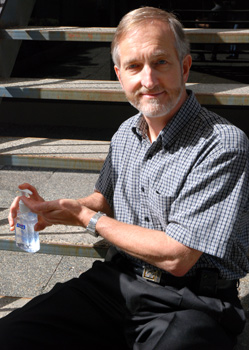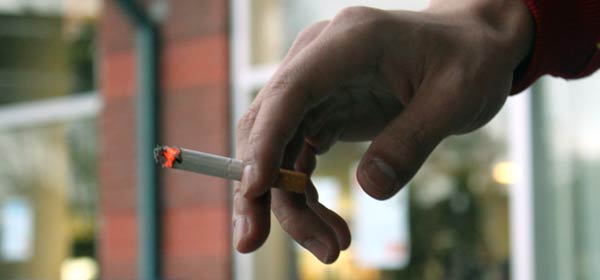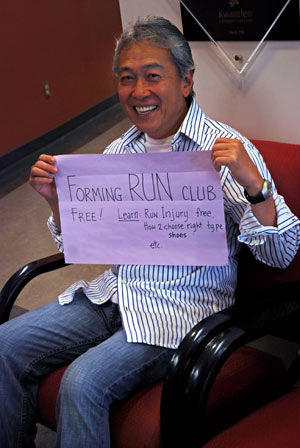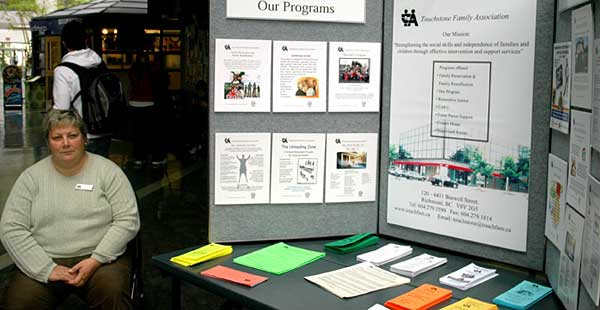Kwantlen students dreaming of more sleep
October 3, 2010 by Jocelyn Gollner · Leave a Comment

Many students are not getting the recommended 8 hours of sleep per night. (Photo by Jocelyn Gollner)
Kwantlen students may not be getting the sleep that they need.
The average amount of sleep that Kwantlen students get each night is six hours, based on an interview with 15 students. According to Dr. Najib Ayas, a member of the Sleep Disorders Program at UBC, students should be getting about eight.
Without a proper amount of sleep, Ayas says that “ your cognition won’t be as good, so you won’t be as alert. And you won’t be able to learn as well.”
If that doesn’t persuade you to get more sleep, he also says that sleep deprivation “affects your appetite hormones and that can actually lead to weight gain.” But with school, work, relationships, family commitments, sports, etc., getting more sleep can be easier said than done.
“I get like six or seven hours of sleep,” said Jennifer Chong, a student at Kwantlen. “If it were my choice I would get way more. Then I would feel way more relaxed.”
When asked what prevents her from getting more sleep, she said it’s mostly studying.
Jina Seo, a design student, also gets about six hours of sleep each night. Does she feel that that is enough?
“No, of course not,” she said.
RELATED: Stress relief for students is a no-brainer
Smoke up, life’s short?
September 21, 2010 by Stu Gallacher · Leave a Comment

A new bylaw went into effect on Sept. 1, prohibiting smokers from lighting up in public parks and on beaches in Vancouver — excluding Wreck Beach, of course.
In a string of initiatives to deter smoking, the new ban is just another drop in the bucket. The bucket, however, is getting pretty full. How long will it be until the right to smoke a cigarette in Vancouver is abolished?
Then again, if the impact of smoking in Vancouver is so harsh and uncompromising, perhaps there’s a greater issue at stake. Why not just make it illegal?
Smoking does appear to be falling into a category of socially unacceptable behaviour, akin to shooting heroin and smoking meth. These days, the satisfaction from inhaling a cigarette in public is rivaled by the ethical judgments of a preeminent non-smoking community.
Besides, how long would it really take for devout smokers, and casual smokers alike, to kick the habit if cigarettes were taken off the market? There’s no shortage of healthy alternatives readily available to fill the void: yoga, swimming, coffee, breathing fresh air. The list goes on. Sadly, they don’t possess all the toxic qualities cigarettes do, and are therefore significantly less attractive pastimes. But why not give it a shot?
Indeed, cigarettes have been around for eons. But change is inevitable. So rather than looking at the new bylaw as a retraction of some inherent spiritual liberty, let’s consider the possibility that the concerned, health-conscious and politically active are genuinely trying to save us from ourselves, one step at a time.
• • •
Here’s what a few students on the Richmond campus had to say about the issue:
Marianna Vilchinsky
Age: 19
Program: General studies
Smoker: Yes
“I think it’s good. If you don’t smoke, I don’t think you should be surrounded by it. But I don’t think it should be banned because it’s still your personal choice.”
Cassidy Scott
Age: 18
Program: Journalism
Smoker: No
“It’s not even politically correct to smoke.”
Kimiya Shokoohi
Age: 20
Program: Journalism
Smoker: Casual
“As a social smoker, I feel like we smoke when we’re having a good time, when we’re out at beaches, when we’re out at parks and together there. So it kind of takes away that activity. It does take away people’s right to smoke, as a smoker and as an individual. Who is anyone to tell me what I can and can’t do?”
Megan Mcnee
Age: 20
Program: Interior design
Smoker: Yes
“I think it’s getting to the point where it could be illegal, in the next decade or so. I wouldn’t say smoking is irreplaceable, but it’s better than doing hard drugs. I suppose you could get physically active, but I prefer smoking.”
Veronica Fraczyk
Age: 26
Program: Accounting
Smoker: No
“I don’t think it’s going to do much. People are going to smoke if they want to. It’s a very serious addiction, and I think they’ll find a way to get around it. I would absolutely vote to get [smoking] off the market.”
Fraser Health predicts and prepares for worst-case flu scenario
January 12, 2010 by Sarah Jackson · Leave a Comment

Dr. Roland Guasparini, chief medical health officer for Fraser Health, models the use of hand sanitizer as protection against H1N1 contraction. (Sarah Jackson photo)
After months of monitoring the southern hemisphere’s H1N1 cases, Fraser Health has determined 40 per cent of the world’s population will catch H1N1 before next April.
The number is twice the yearly 20 per cent seasonal flue infection rate, according to Dr. Roland Guasparini, Fraser Health’s chief medical health officer.
“The vast majority are going to have a mild, self-limiting illness,” Guasparini said. “[But] the flu’s not really mild. You will feel like you get hit with a truck.”
Fraser Health based its estimate on the number of cases that have been reported in the southern hemisphere. As winter and the flu season comes to an end there, the infection rate offers a glimpse into what residents of the northern hemisphere should expect.
Guasparini said Fraser Health has been planning for a severe pandemic for many years, expecting it to surface at any time. The summer arrival of the H1N1 flu suggests that the virus will peak early, over the next eight to 12 weeks, and taper off by December.
The health unit has spent most of its time planning for a worst-case scenario including 200 intensive-care patients, more than Fraser Health facilities can currently house.
To prepare, it has planned alternative treatment sites, purchased additional ventilators and decided how to staff additional health care locations.
“But we’re not going to see that worst-case scenario,” said Guasparini. “We’re expecting, based on the southern hemisphere, that we’ll be able to manage the hospital cases as usual.”
H1N1 is a contagious disease, he explained, so “the attack rate will be the same regardless of the severity of the symptoms.†A mild disease could, however, allow H1N1 to spread more widely than expected if infected people don’t remain home until they recover.
Current concern is for the elderly, children, pregnant women and those with chronic respiratory and cardiac conditions. Those who fall into these categories are at a high risk for severe illness until they receive the H1N1 vaccination, which will not be available until November.
“We’re hoping . . . we just have a seasonal flu year, but the nice thing about all the media attention is that it’s just brought attention to safety conditions,†said Guasparini.
The message about hand-washing, coughing into a shirt sleeve and staying home when sick “has hit home in a big way.â€
He said the media is doing a great job of accurately presenting H1N1 facts. Public-health workers are dealing with the additional strain of responding to patients’ concerns, but the attention devoted to understanding the threats and safety procedures is a new and welcome phenomena.
During previous pandemics, the methods of communication were far more limited.
Guasparini said the international attention and response is a testimony to the system health officials have for monitoring and responding to infectious diseases.
“People are not scared, they just kinda focused their attention.â€
Don MacLachlan, former managing editor at the Province and former director of public relations for Fraser Health, agreed that media has “been doing a very responsible job.â€
MacLachlan said the public perceives H1N1 as a problem, and its status as a pandemic means it is, so the media is rightly informing people about it.
A number of rumours have cropped up since H1N1 first appeared, leaving some people hesitant to trust media coverage. Bulletins have been issued debunking beliefs that H1N1 can be contracted by eating pork, that entire villages in Asia were being wiped out and that the coverage is only hype. But the myths aren’t from the mainstream media, said MacLachlan.
“People aren’t reading or listening to traditional media news. They get news from Facebook, Twitter or MySpace and they treat that as the definitive truth.â€
The media attention has pushed some towards fear or skepticism about the reality of the threat. MacLachlan attributed any “exaggerated state of concern or panic†to individuals who are receiving the media’s messages. He added that “people are hearing and reacting responsibly to responsible messages.â€
Health community ready for outbreak, but virus’s unpredictable nature could ruin plans
January 10, 2010 by Justin Langille · Leave a Comment
Although he sounds fatigued, Dr. James Lu’s voice can only be described as confident when he speaks about the state of the H1N1 outbreak in B.C.
“I think the current concern is making sure the population has the correct information in terms of the level of risk or severity of the pandemic at this point in time, as we understand it,†Lu, the medical health officer for Vancouver Coastal Health in Richmond, said in an interview with the Kwantlen Chronicle.
In its Sept. 22 website bulletin, the Ministry of Health Services reported that 48 B.C. residents had contracted the virus so far. Among those, 21 had been sent to intensive care units and six people with preexisting medical conditions had died from the illness.
Lu said the provincial and federal governments, in conjunction with the B.C. Centre for Disease Control and Vancouver Coastal Health, have followed the guidelines set out by the Public Health Agency of Canada in the B.C Pandemic Influenza Pre-paredness Plan.
Developed in 2005 by the B.C. Ministry of Health and the B.C. Centre for Disease Control, the 200-page document outlines the steps officials are to follow before, during and after a flu-pandemic outbreak, and is consistent with national and international pandemic preparedness protocol, according to the introduction.
Lu said that because of the plan, provincial health authorities were able to quickly and effectively track and monitor the outbreak of the virus, as well as educate the public about how to avoid getting sick. The current rates of death and sickness due to H1N1 in the Lower Mainland are comparable to those for the common flu.
“It’s quite reasonable,†he said of the impact of the H1N1 on B.C residents.
“It’s not any different from what we would expect from seasonal influenza. The sense we have right now is that the health-impact severity is similar to the seasonal flu instead of the 1918 Spanish flu that people are recalling. The majority of the cases are mild.â€
The Spanish flu was a pandemic that killed over 20 million worldwide in 1918 and 1919.
Historians believe that during that pandemic, Vancouver had one of the highest rates of death of any North American city, when 795 of an estimated 4,890 infected people died, according to a June 12, 2009 Vancouver Sun article.
The H1N1 virus has made headlines around the world for being an aggressive flu strain that has killed as many as 3,486 people as of Sept. 18, according to the World Health Organization weekly H1N1 update.
However, Lu insisted that the strain isn’t as aggressive as he and his colleagues had initially thought it was.
“You probably have about 50,000 hospitalizations or so each year from the flu and you would probably would have 4,000 to 5,000 deaths a year from the flu in Canada. I think we’re doing something to help keep H1N1 in that range, but the virus also isn’t as virulent as we feared initially,†he said.
Even so, Lu is advising those who are concerned about contracting H1N1 to make an effort to get the H1N1 vaccine from their local health authorities as it becomes available locally.
According to Lu, the vaccine will gradually become available within the next week, as it is being produced in batches, and is prioritized for vulnerable B.C. populations.
Irene Lanzinger, president of the B.C. Teachers Federation, said that strategies for preventing the spread of flu among students – such as hand washing and covering coughs or sneezes – are being implemented by teachers and schools as students settle into classes.
However, Lanzinger also said that she doesn’t know of any specific plans or strategies put in place by provincial health authorities to protect students.
“The ministry of health and the ministry of education need to make sure that school boards are prepared for what might happen,†she said.
“I don’t know whether they have given instructions to school boards. We really get the sense that there is a little bit of a wait-and-see attitude out there because nobody knows for sure how bad it’s going to be. Having said that, people need to put some plans in place in case something does happen.â€
Lu is optimistic that the H1N1 outbreak in B.C. won’t evolve into a greater crisis, but he is also realistic about the unpredictability of the virus as the flu season hits.
“Because most of us don’t have any immunity to it, I wouldn’t be surprised if come the fall, we do have a large number of people who become ill,†he said.
“Most of it will not need hospitalization or need to be seen by a doctor, but more people may become sick with the flu,†he said. “It may turn out that yes, this virus may be causing a little more severe illness in a healthy person, but it’s hard to sort that out now.â€
KSA rolling papers a doob-ious affair
November 5, 2009 by Jacob Zinn · Leave a Comment

The KSA sells cigarette papers, but don't intend them to be used solely for tobacco. (Jacob Zinn photo)
The Kwantlen Student Association maintains that selling Zig-Zags (paper used to roll tobacco cigarettes and joints) does not conflict with the university promoting anti-smoking products under the student health plan.
Though selling cigarette paper seems to contradict a recent on-campus anti-smoking event, the KSA said it has to provide items for both smokers and non-smokers.
“If people want to smoke medical marijuana, they can,†said Nathan Griffiths, KSA Director of Operations. “If they want to quit smoking tobacco, we’ve provided products to try and have them stop.â€
Griffiths said he doesn’t feel the paper sales are hypocritical in light of the anti-smoking products.
“Currently, we also offer insulin on our health plan, but we still sell Coke, other junk food within the cafe, so I don’t see much of a difference,†said Griffiths.
The concerns of inconsistency on the subject came up during initial KSA talks about supplying Zig-Zag rolling papers.
“We discussed this when we started doing the rolling papers,†said John O’Brian of the Cloverdale KSA. “It was a plebiscite about the legalization of marijuana and it was sort of a close margin.â€
O’Brian said he thought the school would never sell rolling papers, but student demand prompted the sale of Zig-Zags. In the October 2003 plebiscite, out of 784 students who voted, 470 supported the decriminalization of marijuana.
The papers were introduced to the Cloverdale campus in March of this year and then at other campuses.
The separation of Zig-Zag papers from anti-smoking products comes from the concept of not using the cigarette paper to roll cigarettes.
“We don’t intend for them to be used to smoke tobacco,†said O’Brian.
The KSA hasn’t taken a stance on the decriminalization of marijuana, but it does support medical marijuana. Those who smoke marijuana recreationally are not restricted from buying Zig-Zags.
Dr. Balbir Gurm of Kwantlen’s nursing program said she understands the KSA has to support services for smokers, but hopes it doesn’t send mixed messages.
“I think what they have to do is keep the message clear that yes, we want to support people who want to quit smoking, but we can’t turn our backs on those of our members to choose to smoke,†said Gurm.
The sales haven’t really caught on; to date, Cloverdale has sold 32 packs and Surrey has sold 25, with 100 papers to a pack. The Richmond campus hasn’t sold many Zig-Zags and sales at the Langley campus have been discontinued after none were sold.
Because sales have been slow, original plans to add the KSA logo to the papers have been scrapped.
“We were testing to see if they were going to be popular enough,†said O’Brian, who added that even if the papers sold well, a local printing company no longer puts logos on cigarette papers.
KSA may not need H1N1 vaccine in student health plan
November 1, 2009 by Jacob Zinn · Leave a Comment
The Kwantlen Student Association likely won’t have to cover the cost of the H1N1 vaccine for students under its health and dental plan.
The student association originally wanted to include the vaccine in the health plan and subsidize some or all of the cost, but the federal, provincial and territorial governments might pay for vaccinations for students.
“At this stage, it looks like they may be offered for free by the province,†said Desmond Rodenbour, general manger of the KSA. “However, if there is a charge, we’re going to make sure they’re covered under the health and dental plan.â€
The Public Health Agency of Canada has said the federal government will cover 60 per cent of the cost, leaving provincial and territorial governments to cover the difference if they choose.
Although the university provides seasonal flu shots, they will not have H1N1 vaccines on campus, according to Janine Hadfield of the Kwantlen Wellness Centre.
“It’s going to be totally regulated by Public Health,†said Hadfield. “The roll-out starts with [people with] chronic illness and pregnant women, then it goes to young under six and further down the road it’s for the everyday person.â€
Hadfield noted that health regions in the Lower Mainland may distribute the vaccine differently.
Currently, the vaccine is only available to specific groups, such as pregnant women and adults under 65 with chronic illnesses.
Vancouver Coastal Health and Fraser Health is planning to make the H1N1 shot available to everyone in mid-November.
Campuses puts focus on fitness and recreation
October 6, 2009 by Sarah Jackson · Leave a Comment

Elmo Lara, a Student Health Improvement Program coordinator for the KSA, was recruiting students outside Surrey's KSA office on Oct. 5 for the soon-to-come run club. He's working to create programs that show students the relationship between fitness and school success. (Sarah Jackson photo)
New fitness and recreation classes are springing up across Kwantlen campuses this year as part of an initiative to get more students physically fit.
Faculty and the Kwantlen Student Association are trying to get the word out about yoga, belly dancing and hip-hop classes beginning this fall, while they brainstorm ideas for intramural sports, other classes and clubs.
Classes already introduced are hatha yoga (a gentle posture and breathing exercise class), power yoga (a cardio- and strength-intensive exercise class), belly dancing and hip-hop dancing.
Hatha yoga was offered last year and saw a moderate response from students. But small registration numbers are complicating the introduction of the new classes. Though hatha yoga and power yoga had enough registration to start as scheduled in September, the dance classes were delayed for several weeks.
Recreation coordinator John Stewart said getting students interested has been difficult, something he attributes to the lack of awareness about recreation opportunities at Kwantlen.
“You have to build a reputation, and once you get that, you get people coming to you to look for recreation programs. It’ll take some time.â€
The classes, coming intramurals and clubs are being pushed by the faculty and the KSA to promote mind-and-body health.
“If they’re healthy and they’re exercising, their mind is healthy and they’ll do better in school,†Stewart said. “It’s really important to keep yourself active. You think better and you think more clearly.â€
Elmo Lara, a KSA coordinator for the Student Health Improvement Program, is trying to raise awareness about a new running club that is being formed. He works to develop programs that will help students understand the connection between fitness and study success.
“If they’re not physically fit, their brain won’t be working as it should,†he said.
When asked about the relevance of the dance and yoga classes to Kwantlen students, Stewart laughed and said “they were just trying to offer something different. With the hip-hop, they were really trying to focus on something students might be interested in because it’s typically a younger style of [dance].â€
The classes also reflect a gender discrepancy, which Stewart attributed to registration. Females register more frequently than males, he said, but intramural sports are generally male-driven.
Stewart is organizing several recreation classes and intramurals for introduction next semester. Ideas so far include a boot camp, kettlebells and a morning yoga session. Suggestions are welcome; contact John Stewart at (604) 599-2307.
Flu shots
November 14, 2008 by Nick Major · Leave a Comment
Flu shots will be offered to students and staff during the last week of November at all Kwantlen campuses. The cost is $5 for students and $10 for staff (the regular price is $16.50).Â
Shots will be available at:
- Richmond- Nov. 24 from 11 a.m. to 3 p.m.
- Langley- Nov. 25 from 11 a.m. to 3 p.m.
- Cloverdale- Nov. 26 from 10 a.m. to 1 p.m.
- Surrey- Dec. 1 from 11 a.m. to 3 p.m.
To get a shot, make an appointment at KSA Member Services.
New health benefit pays for students’ nicotine replacement
October 24, 2008 by Keira Simmons · Leave a Comment
The KSA has taken an initiative to promote healthier lifestyles for Kwantlen students by including a subsidized Nicotine Replacement Therapy (NRT) in the Student Benefit plan.
The plan is in partnership with the B.C. Lung Association and targets post-secondary students who want to quit smoking. The partnership began with the association’s initiative to have a quit smoking program offered to Kwantlen students.
“The KSA recognized this was something important and we should have (it) in place in our student benefits program,” said Eddie Lee, the Student Health (SHIP) program coordinator. “It kind of worked hand-in-hand that this program is in place with B.C. Lung because with this new benefit package place, we can really serve the students a whole lot better.”
Lee feels that even without B.C. Lung Associations’s initiative, the KSA would have started an NRT plan.
Students can now receive up to $500 for NRTs, including nicotine gum, lozenges, patches, sprays and prescription medicines.
“I can’t say one works better then the other, but I do think we cover all the basis, and we can give students as many options, or tools they need,” said Lee.
Students will be re-reimbursed for over-the-counter NRTs by taking their receipts to the KSA and filling out a claims form. For prescription medicines, students must take their medical card to the pharmacy and they will be automatically covered.
Lee said that creating a smoke-free campus is not the primary goal of the program, but that it is a matter of helping students who want to quit smoking by making resources available.
“We recognize especially with Kwantlen, and with having a trades campus, statistically we have a higher percentage of smoking,” said Lee. “By being part of this initiative, I think we have the resources to help build a successful program here.”
The Student Benefit package (health and hental insurance) costs students $179 a year, although they can opt out if they are already covered by extended medical elsewhere.
Pushing mental health for students
October 17, 2008 by Keira Simmons · 1 Comment

Teresa Vozza of Touchstone Family Association waits to talk to students during the recent health fair at Richmond campus. (Keira Simmons photo)
Six health services groups met in the downstairs rotunda at the Kwantlen Richmond campus on Thursday, Oct, 9, as part of the Mental Illness Awareness Week, Oct. 5-11.
The displays focused on giving students a better understanding of mental illness and raising awareness in the community.
“We are here to expose the services we provide,” said Teresa Vozza, a registered clinical counsellor at Touchstone Family Association.
Most of the agencies and associations that were at the campus are Richmond-based, and provide counselling for individuals suffering from mental illnesses and support groups for families with mentally ill relatives.
“It’s been a very beneficial day for a lot of people,” said Jim Young, 54. “Our aim is to help as many people as possible, and I think we are reaching that goal.” Young is a part-time staffer at Vancouver Coastal Health.
Organizations involved include the Mood Disorders Association of British Columbia, the Chinese Mental Wellness Association of Canada (CMWAC), Vancouver Coastal Health, Chimo Crisis Services and Touchstone Family Association. Also available were a series of UBC research studies on mental health disorders, primarily focusing on bi-polar disorder.


